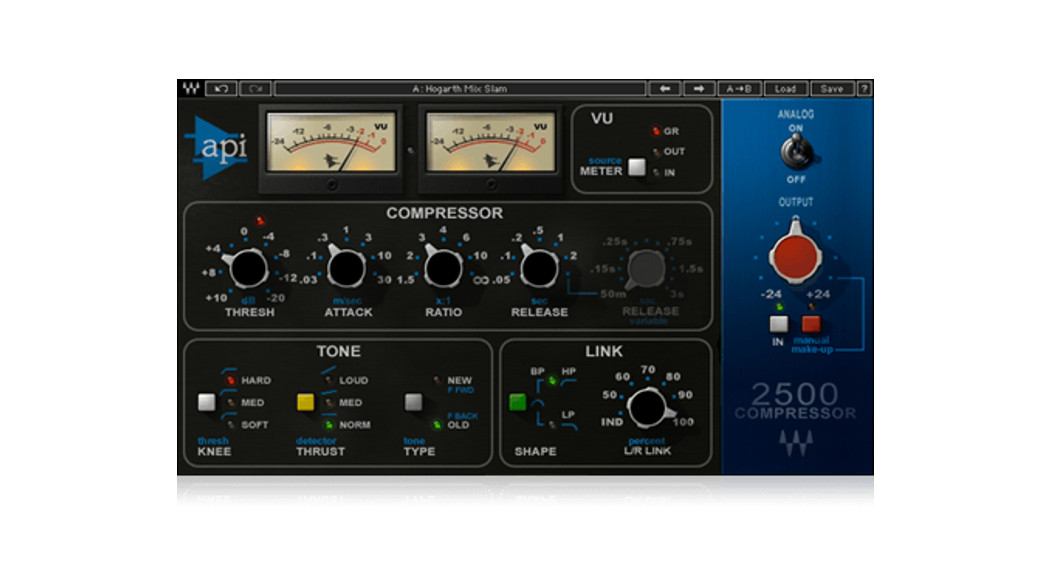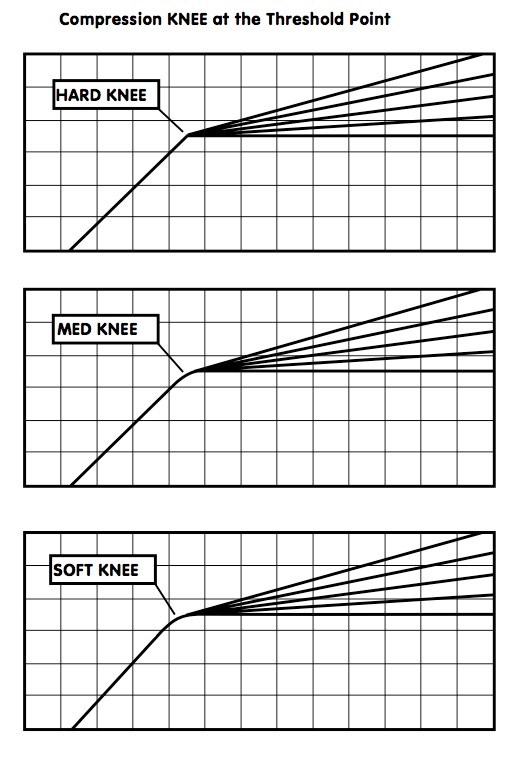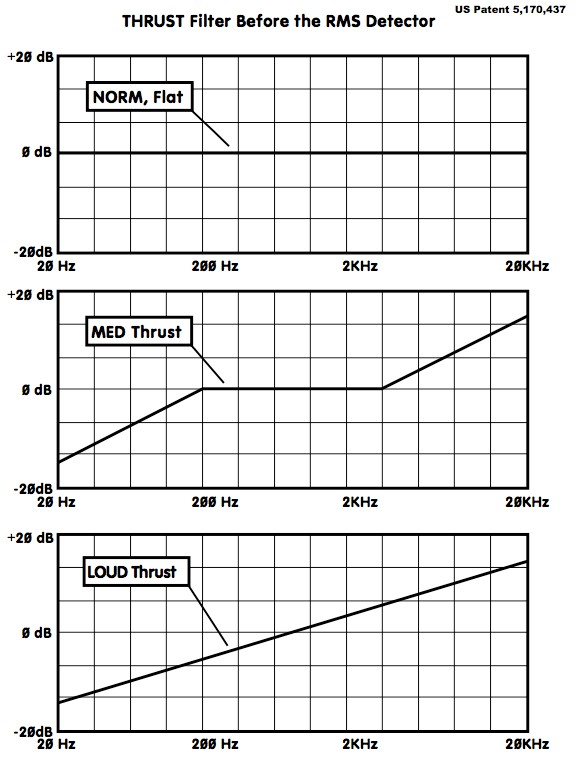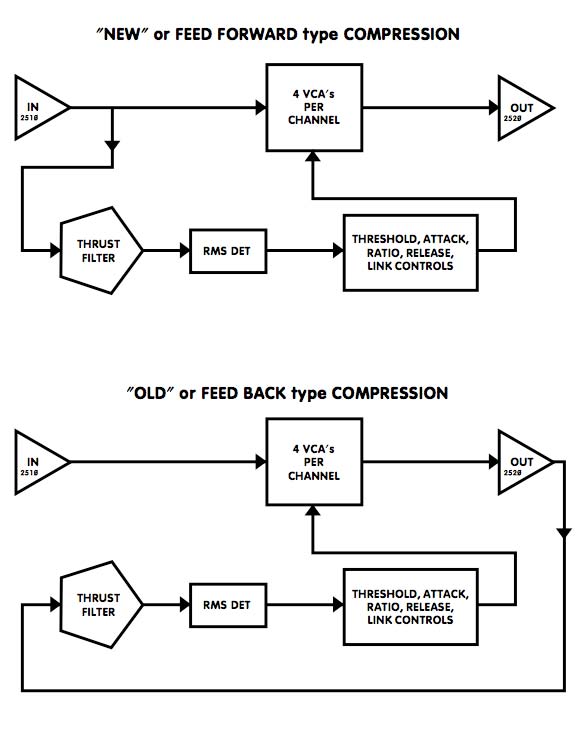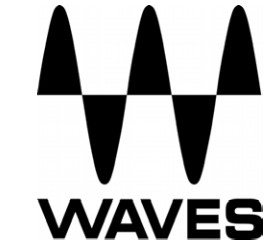
Waves API 2500User Manual
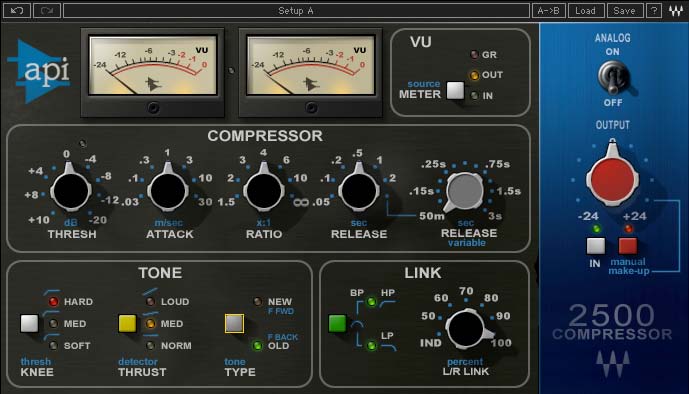
Chapter 1 Introduction
Welcome
Thank you for choosing Waves! In order to get the most out of your new Waves plugin, please take a moment to read this user guide.To install software and manage your licenses, you need to have a free Waves account. Sign up at www.waves.com. With a Waves account you can keep track of your products, renew your Waves Update Plan, participate in bonus programs, and keep up to date with important information.We suggest that you become familiar with the Waves Support pages: www.waves.com/support. There are technical articles about installation, troubleshooting, specifications, and more. Plus, you’ll find company contact information and Waves Support news.
Product Overview
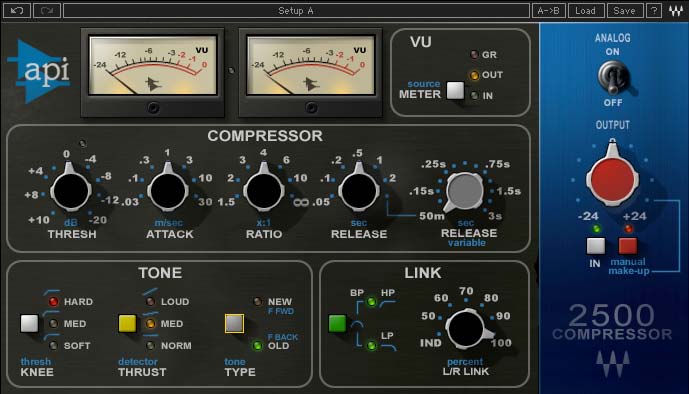
The API 2500 is a versatile dynamics processor that lets you shape the punch and tone of mixes with absolute accuracy. Its dual channel design lets the 2500 also function as two separate mono channels via a single compression setting. Using auto-makeup gain, you can adjust Threshold or Ratio while automatically maintaining a constant output level. With both Feed Back and Feed Forward compression types, the API 2500 boasts a wide range of incredibly musical parameters which have made it a favorite of engineers the world over.
Concepts and Terminology
There are 3 main parameters that set the API 2500 from other compressors: Thrust, Compression Type, and its adjustable Knee. When used in conjunction with one another, these parameters give the API 2500 unprecedented flexibility.
KneeSets the knee, the manner in which the compressor begins to reduce the gain of the signal.
- In the Hard position, gain reduction begins immediately at the set ratio.
- In the Med position, there is a slight fade-in to the set ratio.
- In the Soft position, there is an even more gradual fade-in to the set ratio.

ThrustSets the Thrust, a proprietary process that inserts a High Pass Filter at the RMS detector input, limiting compression response to lower frequencies while applying additional compression to higher frequencies.
- In Norm mode, there is no filter and the 2500 functions like a normal compressor.
- In Med mode, there is a slight attenuation of the low frequencies and a slight boost of the high frequencies, with a flat mid range affecting the signal into the RMS detector. This reduces pumping caused by low frequencies and increases the RMS detectors’ sensitivity to higher frequencies, affecting higher frequency signal peaks.
- In Loud mode, a gradual linear filter attenuates level by 15dB at 20hz and increases level by 15dB at 20khz. This decreases low frequency pumping while increasing higher frequency compression.

TypeSets the Compression type, which determines the signal source being fed to the RMS detector.
- In New (Feed Forward) mode, the compressor works like newer VCA-based compressors. The RMS detector sends a signal to the VCA that is an exact ratio of the desired compression, set by the ratio control.
- In Old (Feed Back) mode, the RMS detector receives a signal from the VCA output, and then feeds the VCA a signal based on the set signal ratio.

Components
WaveShell technology enables us to split Waves processors into smaller plug-ins, which we call components. Having a choice of components for a particular processor gives you the flexibility to choose a configuration suitable for your material.The API 2500 has two component processors:API 2500 Stereo - A stereo compressor that may also be used as two parallel mono processors.API 2500 Mono - A mono compressor with an external sidechain option.
Chapter 2 Quickstart Guide
For those of you who are experienced users of audio signal processing tools, we recommend that you approach the API 2500 as you would any compressor which you are already familiar. Keep in mind that its Thrust, Compression Type, and Knee parameters offer capabilities that transcend other, more conventional, processors.
Newer users should explore the API 2500’s preset library and use its presets as starting points for their own experimentation. These presets also serve as a valuable introduction to compression techniques in general, and offer a glimpse into the workflow of professional audio engineers.We encourage all users to experiment with the API 2500’s settings in order to better understand its unique processing power.
Chapter 3 Controls and Interface
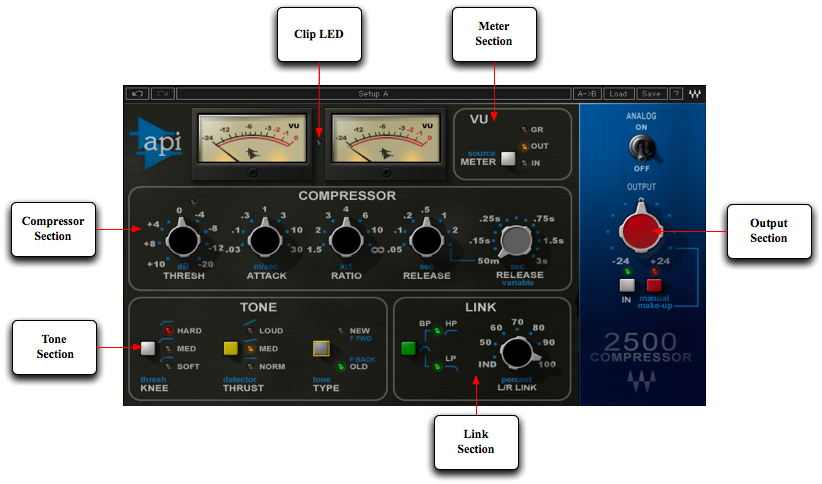
Compressor Section

ThresholdSets the point at which compression begins. Threshold for each stereo channel is set independently, since each channel has its own RMS detector, even in Link mode. In Auto Gain Make-up mode, the Threshold also affects the gain. Threshold is a continuous control.
Range+10dBu to -20dBu (-12dBFS to -42dBFS)Default0dBu
AttackSets the attack time of each channel.Range.03ms, .1ms, .3ms, 1ms, 3ms, 10ms, 30msDefault1ms
RatioSets the compression ratio of each channel. In Auto Gain Make-up mode, Ratio also affects the gain.Range1.5:1, 2:1, 3:1, 4:1, 6:1, 10:1, inf:1Default4:1
ReleaseSets the Release time of the compressor. When set to Variable, Release time is controlled by the Variable Release control, located to the right of the Release control.Range .05sec, .1sec, .2sec, .5sec, 1sec, 2sec, VariableDefault.5sec
Variable ReleaseControls the release time with a continuously variable knob. (Please note: Release control must be set to Variable.)Range.05 seconds to 3 seconds in steps of 0.01msDefault5sec
Tone Section
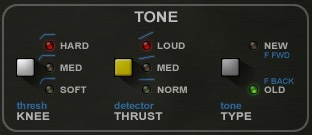
KneeSets the Knee, the manner in which the compressor begins to reduce the signal gain.RangeHard, Med, SoftDefaultHard
ThrustSets the Thrust, a proprietary process that inserts a High Pass Filter at the RMS detector input, limiting compression response to lower frequencies while applying additional compression to higher frequencies.
RangeLoud, Med, NormDefaultNorm
TypeSets the Compression type, which determines the signal source being fed to the RMS detector. Range Feed Back, Feed Forward Default Feed Forward
A note about Sidechain:Sidechain lets you trigger the compressor using an external source, which is fed into the RMS detector and controls the compression of the input signal. Sidechain may only be used in New (Feed Forward) mode. An external sidechain trigger cannot be used in Old (Feed Back) mode; attempting to do so automatically switches the compressor to New (Feed Forward) mode.
Link Section
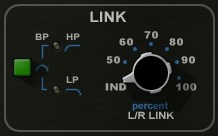
L/R LinkSets the percentage of linkage between the left and right channels. While in Link mode, each channel is still controlled by its own RMS detector, which prevents loading and slaving from either side.
Range IND, 50%, 60%,70%,80%,90%,100%Default100%
ShapeAdjusts the Shape of the link control voltage mixing. The HP (high pass filter, LP low pass filter eliminating the highs and a combination of both filters creating a band pass filter. the value of this circuit allows the Link control voltage to not include certain frequencies. Different filter combinations can be used, for example, to prevent percussive instruments on one channel from coupling and causing unwanted compression on the other channel.
Range HP, LP, BP, OffDefaultOff
Meter Display

MetersThe API 2500’s Meters display dBFS. The Gain scale displays the amount of gain reduction during compression with the 0 point located at the far the right, which allows higher gain reduction scale resolution.. The API 2500 is capable of up to 30dB of reduction.
Range0dB to -24dB (Gain Reduction mode)-24dB to 0dB (Input and Output modes)
Switchable Display ModesRangeGR, Out, InDefaultGR
Clip LEDBetween the two Meters is a Clip LED which indicates input or output clipping. Since the LED shows both input and output clipping, you must determine which of the two levels is excessive. The Clip LED can be reset by clicking on it.
Output Section
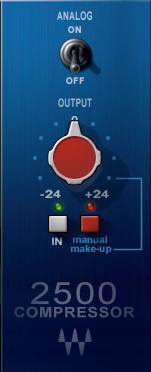
AnalogTurns the Analog modeling on and off.RangeOn/OffDefaultOn
OutputControls the output level in 0.1dB stepsRange+/-24dBDefault0dB
Make-UpTurns Auto Make-Up Gain on and off.RangeAuto, ManualDefaultAuto
InActs as a master bypass for the entire compression chain. When set to Out, all compressor functions are bypassed.RangeIn/OutDefaultIn
WaveSystem Toolbar
Use the bar at the top of the plugin to save and load presets, compare settings, undo and redo steps, and resize the plugin. To learn more, click the icon at the upper-right corner of the window and open the WaveSystem Guide.
Appendix A API 2500 Controls
| Control | Range | Default |
| Threshold | +10dBu to -20dBu | OdBu |
| Attack | .03ms, .1ms, .3ms, 1ms, 3ms, 10ms, 30ms | 1ms |
| Ratio | 1.5:1, 2:1, 3:1 4:1 6:1 10:1 inf:1 | 4:01 |
| Release | .05sec, .1sec, .2sec, .5sec, 1sec, 2sec, Var | .5sec |
| Release Variable | .05 to3sec in steps of 0.01ms | .5sec |
| Knee | Hard, Med, Soft | Hard |
| Thrust | Loud, Med, Norm | Norm |
| Type | FeedBack, Feed forwards | Feed Forwards |
| L/R Link | IND, 50%,60%,70%,80%,90%,100% | 100% |
| Link Filter | Off, HP, LP, BP | Off |
| Make-up | Auto, Manual | Auto |
| Meter | GR, OUT, IN | GR |
| Analog | On/Off | Odeg |
| In | In/Out | In |
| Output | +/-24dB | 0dB |
Waves API 2500 User Manual
References
[xyz-ips snippet=”download-snippet”]

